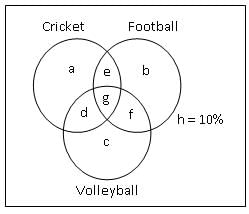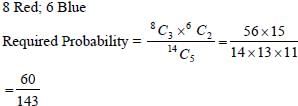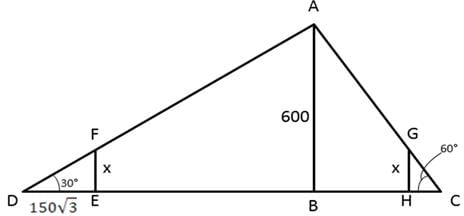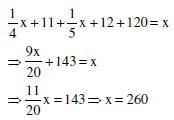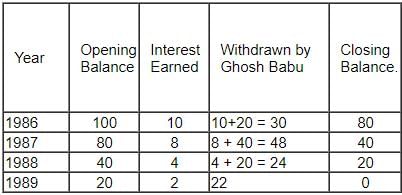Practice Test for IIFT - 4 - CAT MCQ
30 Questions MCQ Test - Practice Test for IIFT - 4
In a class 10% of students play none of the three games: Cricket, Volleyball, Football. 25% play both cricket and football and 55% of students do not play football. 60% play cricket. What percentage of students play only volleyball?
In Bilaspur village, 12 men and 18 boys completed construction of a primary health centre in 60 days, by working for 7.5 hours a day. Subsequently the residents of the neighbouring Harigarh village also decided to construct a primary health centre in their locality, which would be twice the size of the facility built in Bilaspur. If a man is able to perform the work equal to the same done by 2 boys, then how many boys will be required to help 21 men to complete the work in Harigarh in 50 days, working 9 hours a day?
Aniket and Animesh are two colleagues working in PQ Communications, and each of them earned an investible surplus of Rs.1,50,000/- during a certain period. While Animesh is a risk-averse person, Aniket prefers to go for higher return opportunities. Animesh uses his entire savings in Public Provident Fund (PPF) and National Saving Certificates (NSC). It is observed that one-third of the savings made by Animesh in PPF is equal to one-half of his savings in NSC. On the other hand, Aniket distributes his investible funds in share market, NSC and PPF. It is observed that his investments in share market exceeds his savings in NSC and PPF by Rs.20,000/- and Rs.40,000/-respectively. The difference between the amount invested in NSC by Animesh and Aniket is:
In March 2011, EF Public Library purchased a total of 15 new books published in 2010 with a total expenditure of Rs. 4500. Of these books, 13 books were purchased from MN Distributors, while the remaining two were purchased from UV Publishers. It is observed that one-sixth of the average price of all the 15 books purchased is equal to one-fifth of the average price of the 13 books obtained from MN Distributors. Of the two books obtained from UV Publishers, if one-third of the price of one volume is equal to one-half of the price Of the other, then the price of the two books are:
A rectangular piece of paper is 22 cm. long and 10 cm. wide. A cylinder is formed by rolling the paper along its length. Find the volume of the cylinder.
Consider the volumes of the following objects and arrange them in decreasing order:
i. A rectangular parallelepiped of length 5 cm, breadth 3 cm and height 4 cm
ii. A cube of each side 4cm
iii. A cylinder of radius 3 cm and length 3 cm
iv. A sphere of radius 3 cm
If x satisfies the inequality |x - 1| + |x - 2| + |x - 3| ≥ 6, then:
A bag contains 8 red and 6 blue balls. If 5 balls are drawn at random, what is the probability that 3 of them are red and 2 are blue?
A solid metal sphere is melted and smaller sphere of equal radii are formed. 10% of the volumeof the sphere is lost in the process. The smaller spheres have a radius, that is l/9th the largersphere. If 10 litres of paint was needed to paint the larger sphere, how many litresis need topaint all the smaller spheres?
A man is walking towards a street light pole such that his shadow that makes an angle of depression of 30° with the ground, measures 150√3 cm. The height of the street light pole is 600 cm. How far is the man from the pole after crossing it, if the shadow (ahead of him) makes an angle of depression of 60° with the ground?
There are three cities A, B and C. Each of these cities is connected with the other two cities by at least one direct road. If a traveler wants to go from one city to another city she can do so either by traversing a road connecting the two cities directly, or by traversing two roads, the first connecting the origin to the third city and the second connecting the third city to the destination. In all there are 33 routes from A to B. Similarly there are 23 routes from B to C. How many roads are there from A to C directly?
An insurance company earns Rs. 250 per person as annual premium for MEDICLAIM insurance that covers hospitalization bill up to Rs. 18,900 at the rate of 80% of actual bills. It is estimated that only 1 out of every 100 insured persons would incur the hospitalization bill of Rs.15, 000. This scheme costs the insurance company 10% of the revenue as administrative cost. In the situation given above, if instead of 1, 1.6 out of hundred incur hospitalization bills and the company wants to maintain its profit per person, how much should be the premium charged?
Ajay has a watch that loses 20 min a day. This watch is unique in the sense that it shows date also along with the time. If his watch shows 12 pm on 14th March when actual time is 12 am 15th March, when was his watch 12 hours ahead of the actual time (Given it is not a leap year)?
2 / 3rd of the balls in a bag are black, the rest are red. If 5 / 9th of the black balls and 7 / 8th of the red balls are defective, find the total number of balls in the bag, if the number of non-defective balls is 146.
There are 10 different fruits and 5 different vegetables. A grocer has to choose 3 fruits and 2 vegetables. In all the possible selections he can make, what is the number of selections in which a particular fruit and a particular vegetable are always there?
In a school every student takes at least one subject among History and Physics. One fourth of the total students and 11 more took History only. One fifth of the total students and 12 more took Physics only. The remaining 120 students took both the subjects. Find the number of students in the school.
Two teams participating in a competition had to take a test in a given time. Team B chose the easier test with 300 questions, and team A the difficult test with 10% less questions. Team A completed the test 3 hours before schedule while team B completed it 6 hours before schedule. If team B answered 7 questions more than team A per hour, how many questions did team A answer per hour?
A line is drawn from top left corner to the bottom right corner of a rectangle ABCD making it into two triangles, Area 1 and 2. Then,
The diameter of the smaller circle is equal to the side of a square and the diagonal of this square is equal to the diameter of the bigger circle. The area of the smaller circle to the bigger circle is in the ratio:
By what least number 21, 600 should be multiplied to make it a perfect cube?
Jack speaks the truth in 1 / 4th cases and Jill lies in 2 / 5th cases. What is the percentage of cases in which both Jack and Jill contradict each other in stating a fact? (The answers can only be “yes” or “no”)
If log4 (x – 3) = 1 – log4 (x – 6), what is the value of x?
The sum of the reciprocals of the ages of two colleagues is five times the difference of the reciprocals of their ages. If the ratio of the product of their ages to the sum of their ages is 14.4 : 1, the age (in years) of one of the colleagues must be between (both inclusive) ________
A cyclist completes first half of his journey at the rate of 10 km/h and second half at increasing his speed by 50%. The average speed of whole journey is
DIRECTIONS for the question: Solve the following question and mark the best possible option.
Ghosh Babu deposited a certain sum of money in a bank in 1986. The bank calculated interest on the principal at 10 percent simple interest, and credited it to the account once a year. After the 1st year, Ghosh Babu withdrew the entire interest and 20% of the initial amount. After the 2nd year, he withdrew the interest and 50% of the remaining amount. After the 3rd year, he withdrew the interest and 50% of the remaining amount. Finally after the 4th year, Ghosh Babu closed the account and collected the entire balance of Rs. 11,000.
Q. The year, at the end of which, Ghosh Babu withdrew the smallest amount was:
DIRECTIONS for the question: Read the passage and answer the question based on it.
We are well into the 21st century yet half the world's population live in squatter settlements and work in shadow economies, which generate more than one-third of the developing world's GDP. Slums are not caused by the poor but by governments denying people the right to own and exchange property. When people own their own property they have incentives to invest time, money and energy to improve it because they know that they will be able to benefit from any such improvements, i.e. the ability to obtain mortgages etc. In short, property rights beget capital, which begets innovation, which begets wealth. Sadly, the poor typically don't have secure title to their land as there are bureaucratic restrictions on transferring title or there is no clear system for titling. Without legal deeds they live in constant fear of being evicted by landlords or municipal officials. Illiteracy is a major reason poor people often choose not to seek the protection of local courts since in so many countries laws established under colonial rule have never been translated into local languages. When entrepreneurs do set out to legally register business they are discouraged by red tape and costly fees. In Egypt, starting a bakery takes 500 days, compliance with 315 laws and 27 times the monthly minimum wage. The proprietors of such businesses cannot get loans, enforce contracts or expand a personal network of familiar customers and partners. As a result the poor have no choice but to accept insecurity and instability as a way of life.
In India severe restrictions on free transfer of property in most rural areas inhibit investment and encourage urban flight. Planning policies however discourage building homes for these migrants as numerous homes are destroyed if they do not comply with planning rules, essentially forcing people to live in slums and perversely blaming it on population growth. UN Habitat, the UN agency for housing the poor, has implemented more plans to stabilise the unplanned aspects of urban growth but grandiose plans like UN Schemes and government housing projects simply ignore or worsen the underlying problems. It is when governments grant people legal means to control their assets that they empower them to invest and plan ahead. In Buenos Aires, economists studied the experience of two Argentine communities. One had received legal title to its land in the 1980s and surpassed the other group which had not, in a range of social indicators including quality of house construction and education levels. The Commission on Legal Empowerment of the Poor - a UN -affiliated initiative made up of two dozen leaders - is exploring ideas to extend enforceable legal rights to impoverished members of society and is seeking to bring about a consensus on incentives for national and local leaders. As the growth of illegal settlements amply demonstrates, the poor are not helpless, all they need is governments to grant them fundamental human rights of freedom and responsibility.
Q. What did the Argentine study indicate?
A. Argentina's economy is booming and the percentage of poor has fallen.
B. When the government gives people the legal means to control their assets they plan for the future.
C. The Government succeeded in widening the gap between the rich and the poor.
DIRECTIONS for the question: Read the passage and answer the question based on it.
We are well into the 21st century yet half the world's population live in squatter settlements and work in shadow economies, which generate more than one-third of the developing world's GDP. Slums are not caused by the poor but by governments denying people the right to own and exchange property. When people own their own property they have incentives to invest time, money and energy to improve it because they know that they will be able to benefit from any such improvements, i.e. the ability to obtain mortgages etc. In short, property rights beget capital, which begets innovation, which begets wealth. Sadly, the poor typically don't have secure title to their land as there are bureaucratic restrictions on transferring title or there is no clear system for titling. Without legal deeds they live in constant fear of being evicted by landlords or municipal officials. Illiteracy is a major reason poor people often choose not to seek the protection of local courts since in so many countries laws established under colonial rule have never been translated into local languages. When entrepreneurs do set out to legally register business they are discouraged by red tape and costly fees. In Egypt, starting a bakery takes 500 days, compliance with 315 laws and 27 times the monthly minimum wage. The proprietors of such businesses cannot get loans, enforce contracts or expand a personal network of familiar customers and partners. As a result the poor have no choice but to accept insecurity and instability as a way of life.
In India severe restrictions on free transfer of property in most rural areas inhibit investment and encourage urban flight. Planning policies however discourage building homes for these migrants as numerous homes are destroyed if they do not comply with planning rules, essentially forcing people to live in slums and perversely blaming it on population growth. UN Habitat, the UN agency for housing the poor, has implemented more plans to stabilise the unplanned aspects of urban growth but grandiose plans like UN Schemes and government housing projects simply ignore or worsen the underlying problems. It is when governments grant people legal means to control their assets that they empower them to invest and plan ahead. In Buenos Aires, economists studied the experience of two Argentine communities. One had received legal title to its land in the 1980s and surpassed the other group which had not, in a range of social indicators including quality of house construction and education levels. The Commission on Legal Empowerment of the Poor - a UN -affiliated initiative made up of two dozen leaders - is exploring ideas to extend enforceable legal rights to impoverished members of society and is seeking to bring about a consensus on incentives for national and local leaders. As the growth of illegal settlements amply demonstrates, the poor are not helpless, all they need is governments to grant them fundamental human rights of freedom and responsibility.
Q. According to the author, which of the following factors is responsible for the creation of a slum?
DIRECTIONS for the question: Read the passage and answer the question based on it.
We are well into the 21st century yet half the world's population live in squatter settlements and work in shadow economies, which generate more than one-third of the developing world's GDP. Slums are not caused by the poor but by governments denying people the right to own and exchange property. When people own their own property they have incentives to invest time, money and energy to improve it because they know that they will be able to benefit from any such improvements, i.e. the ability to obtain mortgages etc. In short, property rights beget capital, which begets innovation, which begets wealth. Sadly, the poor typically don't have secure title to their land as there are bureaucratic restrictions on transferring title or there is no clear system for titling. Without legal deeds they live in constant fear of being evicted by landlords or municipal officials. Illiteracy is a major reason poor people often choose not to seek the protection of local courts since in so many countries laws established under colonial rule have never been translated into local languages. When entrepreneurs do set out to legally register business they are discouraged by red tape and costly fees. In Egypt, starting a bakery takes 500 days, compliance with 315 laws and 27 times the monthly minimum wage. The proprietors of such businesses cannot get loans, enforce contracts or expand a personal network of familiar customers and partners. As a result the poor have no choice but to accept insecurity and instability as a way of life.
In India severe restrictions on free transfer of property in most rural areas inhibit investment and encourage urban flight. Planning policies however discourage building homes for these migrants as numerous homes are destroyed if they do not comply with planning rules, essentially forcing people to live in slums and perversely blaming it on population growth. UN Habitat, the UN agency for housing the poor, has implemented more plans to stabilise the unplanned aspects of urban growth but grandiose plans like UN Schemes and government housing projects simply ignore or worsen the underlying problems. It is when governments grant people legal means to control their assets that they empower them to invest and plan ahead. In Buenos Aires, economists studied the experience of two Argentine communities. One had received legal title to its land in the 1980s and surpassed the other group which had not, in a range of social indicators including quality of house construction and education levels. The Commission on Legal Empowerment of the Poor - a UN -affiliated initiative made up of two dozen leaders - is exploring ideas to extend enforceable legal rights to impoverished members of society and is seeking to bring about a consensus on incentives for national and local leaders. As the growth of illegal settlements amply demonstrates, the poor are not helpless, all they need is governments to grant them fundamental human rights of freedom and responsibility.
Q. The author's main objective in writing the passage is to
DIRECTIONS for the question: Read the passage and answer the question based on it.
We are well into the 21st century yet half the world's population live in squatter settlements and work in shadow economies, which generate more than one-third of the developing world's GDP. Slums are not caused by the poor but by governments denying people the right to own and exchange property. When people own their own property they have incentives to invest time, money and energy to improve it because they know that they will be able to benefit from any such improvements, i.e. the ability to obtain mortgages etc. In short, property rights beget capital, which begets innovation, which begets wealth. Sadly, the poor typically don't have secure title to their land as there are bureaucratic restrictions on transferring title or there is no clear system for titling. Without legal deeds they live in constant fear of being evicted by landlords or municipal officials. Illiteracy is a major reason poor people often choose not to seek the protection of local courts since in so many countries laws established under colonial rule have never been translated into local languages. When entrepreneurs do set out to legally register business they are discouraged by red tape and costly fees. In Egypt, starting a bakery takes 500 days, compliance with 315 laws and 27 times the monthly minimum wage. The proprietors of such businesses cannot get loans, enforce contracts or expand a personal network of familiar customers and partners. As a result the poor have no choice but to accept insecurity and instability as a way of life.
In India severe restrictions on free transfer of property in most rural areas inhibit investment and encourage urban flight. Planning policies however discourage building homes for these migrants as numerous homes are destroyed if they do not comply with planning rules, essentially forcing people to live in slums and perversely blaming it on population growth. UN Habitat, the UN agency for housing the poor, has implemented more plans to stabilise the unplanned aspects of urban growth but grandiose plans like UN Schemes and government housing projects simply ignore or worsen the underlying problems. It is when governments grant people legal means to control their assets that they empower them to invest and plan ahead. In Buenos Aires, economists studied the experience of two Argentine communities. One had received legal title to its land in the 1980s and surpassed the other group which had not, in a range of social indicators including quality of house construction and education levels. The Commission on Legal Empowerment of the Poor - a UN -affiliated initiative made up of two dozen leaders - is exploring ideas to extend enforceable legal rights to impoverished members of society and is seeking to bring about a consensus on incentives for national and local leaders. As the growth of illegal settlements amply demonstrates, the poor are not helpless, all they need is governments to grant them fundamental human rights of freedom and responsibility.
Q. What benefit does the author see in providing land ownership rights to the poor?
DIRECTIONS for the question: Read the passage and answer the question based on it.
The tale of reading begins when the retina receives photons reflected off the written page. But the retina is not a homogeneous sensor. Only its central part, called the fovea, is dense in high-resolution cells sensitive to incoming light, while the rest of the retina has a coarser resolution. The fovea, which occupies about 15 degrees of the visual field, is the only part of the retina that is genuinely useful for reading. When foveal information is lacking, whether due to a retinal lesion, to a stroke having destroyed the central part of the visual cortex, or to an experimental trick that selectively blocks visual inputs to the fovea, reading becomes impossible."
The need to bring words into the fovea explains why our eyes are in constant motion when we read. By orienting our gaze, we "scan" text with the most sensitive part of our vision, the only one that has the resolution needed to determine letters. However, our eyes do not travel continuously across the page.' Quite the opposite: they move in small steps called saccades. At this very moment, you are making four or five of these jerky movements every second, in order to bring new information to your fovea. Even within the fovea, visual information is not represented with the same precision at all points. In the retina as well as in the subsequent visual relays of the thalamus and of the cortex, the number of cells allocated to a given portion of the visual scene decreases progressively as one moves away from the center of gaze. This causes a gradual loss of visual precision. Visual accuracy is optimal at the center and smoothly decreases toward the periphery. We have the illusion of seeing the whole scene in front of us with the same fixed accuracy, as if it were filmed by a digital camera with a homogeneous array of pixels. However, unlike the camera, our eye sensor accurately perceives only the precise point where our gaze happens to land. The surroundings are lost in an increasingly hazy blurriness
One might think that, under these conditions, it is the absolute size of printed characters that determines the ease with which we can read: small letters should be harder to read than larger ones. Oddly enough, however, this is not the case. The reason is that the larger the characters, the more room they use on the retina. When a whole word is printed in larger letters, it moves into the periphery of the retina, where even large letters are hard to discern. The two factors compensate for each other almost exactly, so that an enormous word and a minuscule one are essentially equivalent from the point of view of retinal precision. Of course, this is only true provided that the size of the characters remains larger than an absolute minimum, which corresponds to the maximal precision attained at the center of our fovea. When visual acuity is diminished, for instance in aging patients, it is quite logical to recommend books in large print .Our eyes impose a lot of constraints on the act of reading. The structure of our visual sensors forces us to scan the page by jerking our eyes around every two or three tenths of a second Reading is nothing but the word-by-word mental restitution of a text through a series of snapshots. 'file some small grammatical words like "the," "it or "is" can sometimes be skipped, almost all content words such as nouns and verbs have to be fixated at least once.
These constraints are an integral part of our visual apparatus and cannot be lifted by training. One can certainly teach people to optimize their eye movements patterns, but most good readers, who read four hundred words per minute, are already close to optimal. Given the retinal sensor at our disposal, it is probably not possible to do much better. A simple demonstration proves that eye movements are the rate-limiting step in reading. If a full sentence is presented, word by word, at the precise point where gaze is focalized, thus avoiding the need for eye movements, a good reader can read five hundred words per minute at staggering speed-a mean of eight hundred words per minute, and up to sixteen hundred words per minute for the best readers, is about one word every forty milliseconds and three to four times faster than normal reading! With this method, called rapid sequential visual presentation, or RSVP, identification and comprehension remain satisfactory, thus suggesting that the duration of those central steps does not impose a strong constraint on normal reading. Perhaps this computerized presentation mode represents the future of reading in a world where screens progressively replace paper.
At any rate, as long as text is presented in pages and lines, acquisition through gaze will slow reading and impose an unavoidable limitation. Thus, fast reading methods that advertise gains in reading speed of up to one thousand words per minute or more must be viewed with skepticism. One can no doubt broaden one's visual span somewhat, in order to reduce the number of saccades per line, and it is also possible to learn to avoid moments of regression, where gaze backtracks to the words it has just read. However, the physical limits of the eyes cannot be overcome, unless one is willing to skip words and thus run the risk of a misunderstanding. Woody Allen described this situation perfectly: "I took a speed-reading course and was able to read War and Peace in twenty minutes. It involves Russia."
Q. Why does the author recommend books in larger print for old people?


